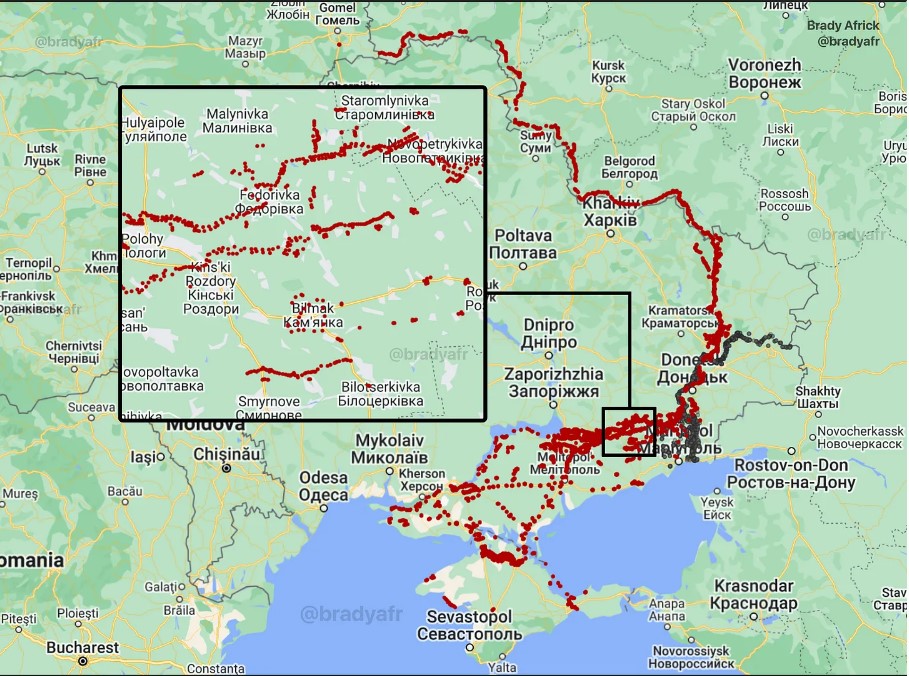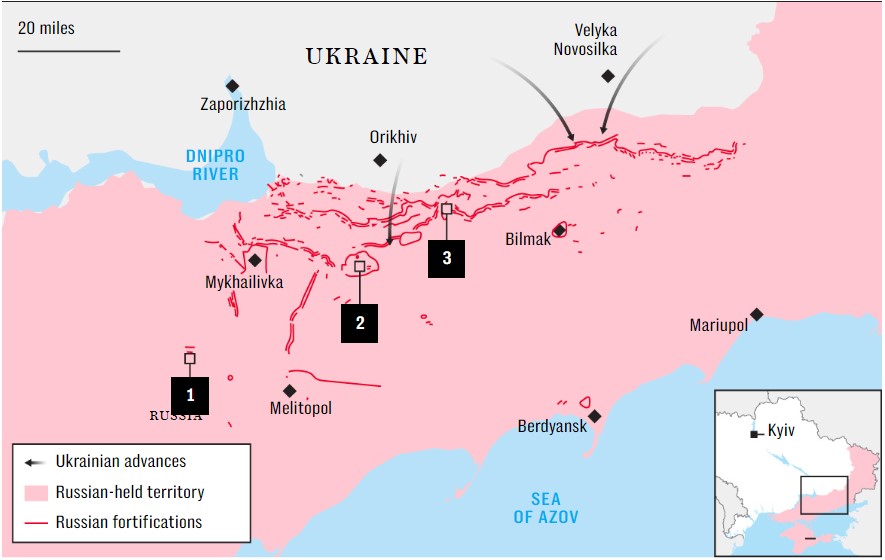Mines, trenches, 'dragon's teeth': How Russia fortified itself in three defense lines, but couldn't stop Ukraine
 Photo: Russia has dug in three defense lines in Ukraine and is trying to restrain the offensive (Getty Images)
Photo: Russia has dug in three defense lines in Ukraine and is trying to restrain the offensive (Getty Images)
Ukrainian troops are engaged in fierce fighting as they breach Russian defenses on the southern front, where three defense lines are built, significantly slowing down the Ukrainian advance.
What are the Russian defense lines and where the Ukrainian forces are managing to break through? Read the RBC-Ukraine report to find out.
After breaking through in Robotyne, Zaporizhzhia region, the Russians are attempting to reinforce their second and third lines, as Spokesperson for the Southern Defense Forces Natalia Humeniuk says.
According to her, the enemy is building additional concrete structures, fortifying their positions, and trying to dig even deeper into the ground. Presumably, Russians understand that they will need the second and third lines in the near future.
Deputy Minister of Defense Hanna Maliar emphasizes that Ukrainian soldiers are gaining a foothold at new positions, and the battles are intense. The defense lines are not like those shown in movies.
"Everything is happening in stages. In certain areas, we have breached the first line. Within some areas, we are approaching the second defense line," she explained.
As The Wall Street Journal reported, Chief of the General Staff of the Armed Forces of Ukraine Valerii Zaluzhnyi assured Western colleagues that the Ukrainian army is on the verge of a breakthrough at the frontline. It has been two and a half months since the start of the summer campaign, and for someone, progress might seem slow.
The Russians had a lot of time to fortify their positions in the south. Understanding how their defense lines are arranged is crucial, as they halt Ukraine's advance, at least for now.
Almost circular defense
Russia began constructing challenging fortifications in the second half of 2022, following Ukraine's rapid fall advance in the Kharkiv and Kherson regions and in Donbas.
Initially, there was no unified defensive line. For example, in the Donetsk and Luhansk regions, mercenaries from the Wagner PMC built the so-called Wagner line or Prigozhin line (named after the Wagner chief Yevgeny Prigozhin), while on the left bank of the Dnipro River in the Kherson region, the army erected the Surovikin line (named after those time commander of the occupying forces Sergey Surovikin).

Photo: Defense lines stretched from the northern border regions to Crimea (OSINT analysis by Brady Africk)
Simultaneously, fortifications were being built in the Belgorod and Kursk regions of Russia. By May 2023, a continuous line had been drawn from the northeastern Ukraine-Russia borders to the Crimean Peninsula.
When people talk about the Wagner and Surovikin lines, they usually refer to concrete pyramids ("dragon's teeth") prepared to obstruct the advancement of Ukrainian vehicles. However, these are elements of a more complex system.
Oleksandr Musiienko, the head of the Center for Military-Legal Research, explains what the enemy relies on while defending their positions.
"While talking about the lines, they mean a network of trenches and dugouts, as well as fortified areas where dugouts are reinforced not only with wood but also with concrete. In other words, these are small bunkers used for command posts near the frontline. This also includes minefields, concrete barriers, and large anti-tank ditches," he noted in a comment to RBC-Ukraine.
In the most fortified areas of the Zaporizhzhia region and the Crimean Peninsula, the defense consists of three lines.
Three defense lines - What's the difference
According to satellite images, the multi-level defense stretches for hundreds of kilometers along the frontline. In some directions, it can reach up to 30 kilometers deep into the occupied south.

Photo: Scheme of Russian defense in the south (telegraph.co.uk)
For example, in a satellite image of the area near Mykhailivka (40 km west of Tokmak), you can see anti-tank ditches, which are rear defensive positions located about 20 km behind the frontline. In front of them are the "dragon's teeth," and closer to the front are trenches for infantry.

Photo: Russian defensive lines in the Mykhailivka area of the Zaporizhzhia region (telegraph.co.uk)
But this is just one example. The adversary often places deep trenches in front of landings, using them to camouflage artillery positions. And in front of their trenches, they densely mine the fields.
Musiienko explains that a network of trenches and dugouts is typical for all defense lines, and overall, the principle of their organization is quite similar.
"The difference is that the second and third lines have more concrete bunkers because that's where the command and coordination units for combat operations are located," he added.
According to the UK Royal United Services Institute, the Russian defense of Ukraine looks like this:
- First line - infantry positions
- Second line - trenches with so-called "foxholes" (full-profile trenches with niches where infantry hides from bombardments or artillery strikes). In front of the second line are the "dragon's teeth" and anti-tank ditches with a depth of 4 meters and a width of 6 meters, as well as barbed wire barriers.
- Third line - positions for heavy equipment and shelters for reserves.
Russian fortifications are considered some of the largest defensive structures ever built. They can stretch along the frontline from Crimea to Donbas.
Photo: Scheme of Russian defense (telegraph.co.uk infographic)
Military-political analyst for the Information Resistance group, Oleksandr Kovalenko, clarifies the scheme. According to him, the first line is a support belt. It includes minefields, trenches, secret positions with anti-tank rocket systems, and machine gun points. Its purpose is to block and stop advancing forces.
The second line is the main one. It includes motorized infantry units, armored vehicles, and tanks - as well as artillery covering the first line.
"The third line is rearward. It mainly contains logistics, ammunition depots, fuel, headquarters, repair bases, command posts, and hospitals. It also includes air defense assets of various echelons. Moreover, when a breakthrough occurs from the first line to the second, the artillery is moved to the third," he explained.
No way to bypass
The Russian defense in three lines stretches along almost the entire southern front. Of course, some sections are denser, and some are less so. Currently, the Ukrainian Armed Forces are advancing in the Berdyansk and Melitopol directions. Since June 2023, they have liberated about a dozen settlements.
According to Oleksandr Musiienko, before the counteroffensive, the Ukrainian forces repeatedly conducted reconnaissance by fire and reconnaissance of the area, assessing the enemy's defense. Today, it's evident that all lines are roughly at the same level.
"If we had the opportunity to bypass them, like the Maginot Line in France when the Germans went through Belgium's forests, we probably would have used it. We could have, for example, conducted a flanking operation from the right bank to the left bank of the Kherson region, where they might not be as strongly fortified. Although our forces are trying to do this now, the enemy is resisting, so, most likely, the defense lines are roughly the same everywhere in the south," he explained to RBC-Ukraine.
Oleksandr Kovalenko emphasizes that while choosing the location to advance, the Ukrainian forces were interested not only in the density of the Russian defense lines but also in the directions they could move forward.
"If somewhere the defense is not as dense, but there are fields, forests, and swamps, then advancing will be much more difficult than through a saturated defense but with logistical potential. Important factors also include the presence of dominant heights, geographical, and landscape features," the expert explained.
Where the defense is breached and how far the Ukrainian Armed Forces have advanced
Currently, Ukrainian forces have breached the first line and reached the second in some areas of the frontline. This is primarily in the area of the village of Robotyne.
 Photo: After Robotyno, the Armed Forces almost reached Novoprokopivka (deepstatemap.live)
Photo: After Robotyno, the Armed Forces almost reached Novoprokopivka (deepstatemap.live)
Analysts from ISW have noted tactical reports from Russia indicating that their special forces are occupying positions behind the first line, possibly even behind the second line. Within the ranks of the occupiers, there is already talk of a critical moment on the battlefield. This suggests that the second line may be less defended than expected.
Oleksandr Kovalenko is confident that Ukrainian troops have already reached the second line in the area between Robotyne and the village of Verbove. A beachhead is currently being formed there for further breakthroughs. According to the General Staff, there is progress towards Novoprokopivka.
As for the Berdyansk direction on the administrative border of the Zaporizhzhia and Donetsk regions, the breakthrough of the first line continues south of the village of Urozhaine.
"If we reach Staromlynivka, this can be considered a breakthrough of the first defense line. The village of Zavitne Bazhannia, which needs to be liberated, is still on the first line, while Kermenchyk and Staromlynivka are already on the second line," he explained in a comment to RBC-Ukraine.
 Photo: The Armed Forces have almost reached the village of Zavitne Bazhannia, but have not yet broken through the first line (deepstatemap.live)
Photo: The Armed Forces have almost reached the village of Zavitne Bazhannia, but have not yet broken through the first line (deepstatemap.live)
The Staromlynivka beachhead opens up an operational space towards the next fortifications, located 20 kilometers from Mariupol and the road to Berdyansk.
In terms of the logic of combat operations, breaking through the first line is the most challenging task for advancing forces, while breaking through the second line is the most crucial.
"The first line is equipped to a depth of up to 5 km, and the next one is up to 15 km deep. But if it starts crumbling in the first third, it will be very problematic for the Russians to stop the cascading effect. Therefore, it's important to advance quickly, act proactively to deprive them of the opportunity to occupy new positions and prepare for defense," the expert added.

